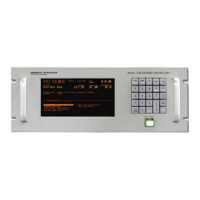Theory
All of these solutions are generated using the method described previously. The
differences in the solutions are due to the time span of AST data used, and the
propagator used. The ST will use up to the last 10 hours of data available, while
the LT (2b and mb) will use up to the last 73 hours of data available.
Assuming that tracking is started on a target with no stored AST data, the first ST
solution will be available for use approximately 90 minutes after tracking begins.
The first LT2b solution will be available 18 hours after tracking begins. The first
LTmb solution will be available 35 hours after tracking begins.
The choice of which solution to use for tracking is made after each steptrack cycle
by comparing the peak position with the predicted positions from all available
models. The solution that produces a position closest to the steptrack peak is
used.
3.2 Orbit Scan
The 7200 ACU has a satellite-locating algorithm referred to as Orbit scan. The
purpose of Orbit scan is to locate satellites in inclined operation. This method is
superior to other scanning methods such as Box Scan, Spiral Scan, or Raster Scan.
Orbit scan will only search the most probable path of the satellite and not waste
time in empty sky.
The Orbit scan mode is a user-selectable option on the OPT tracking. If enabled,
Orbit scan will be used when no OPT solutions exist, and no signal is available at
current pointing or at box center for the designated target.
3.2.1 Orbit Scan Theory
This scan method will only be effective for geosynchronous satellites in inclined
operation. It is assumed that the satellite owners are attempting to hold nominal
longitude and a near circular orbit.
The 7200 ACS creates a set of orbital parameters that place the ascending node at
nominal longitude and provide the estimated inclination. The resulting trajectory
will follow the most likely path for a satellite in this type of operation. From the
site point of view, this produces a figure 8 (approximately) which is followed from
box center. The system always starts by traveling north from box center, all the
way around the figure 8 and back to box center (refer to Figure 3-1). This will
work correctly regardless of site to satellite orientation. (Note: Figure 3-1 shows
the scan in terms of latitude/longitude. The trajectory will look different in terms of
AZ/EL based on site position and satellite position.)
3-3

